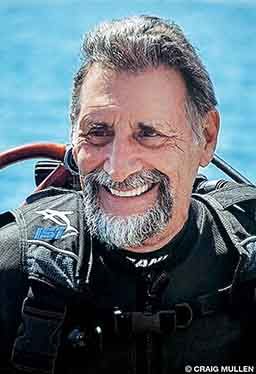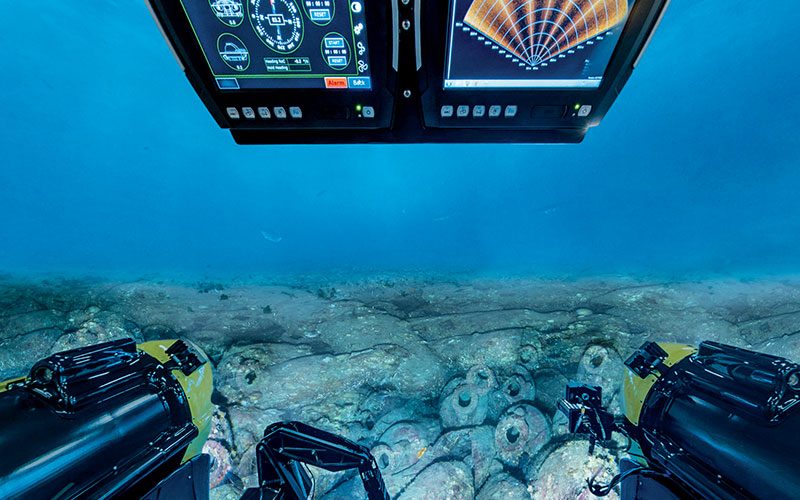Being the first to do something is never easy. Just ask Ian Koblick. Koblick, a marine explorer and educator, has challenged the way we think about and interact with the ocean for more than four decades, from living beneath the waves to probing its deepest secrets. His latest venture, offering underwater thrill-seekers a glimpse of ancient history through the windows of a luxury submersible, is another in a long string of world firsts. And as he knows all too well, that’s no guarantee of success.
“I’ve done a whole lot of things in my life that were ‘the first,'” Koblick said, “but being first isn’t always the best place to be.”
Total Immersion

Koblick was one of the pioneers of undersea living, beginning in the late 1960s with the Tektite underwater research laboratory in the U.S. Virgin Islands, the first nationally sponsored “scientists in the sea” program. In addition to being an aquanaut, he helped manage the science missions for the Tektite II expedition in 1970, which featured the first all-female aquanaut team, including a young Sylvia Earle.
Inspired by his Tektite experiences, Koblick founded the Marine Resources Development Foundation in 1970 with the aim of sharing the world of “inner space” with everyone from schoolchildren to astronauts. He designed and managed the undersea lab for the Puerto Rico International Undersea Laboratory, dubbed La Chalupa, from 1971 to 1976 before returning to Florida to work with the U.S. Department of Commerce to develop a national ocean program.
Koblick and his colleague, Neil Monney, Ph.D., later acquired La Chalupa, moved it to Key Largo, Fla., and converted it into the world’s first underwater hotel, the Jules’ Undersea Lodge, which opened in 1986. He had hoped it would spawn a wave of subsurface accommodations around the world, but nearly 30 years later it remains the only one of its kind.
“My whole goal the last 40 years has been to make people aware of the importance of the ocean,” Koblick said, whether that’s through marine education or firsthand experiences like a stay at the Jules’. That drive is what has pushed him to constantly seek new projects, new undersea adventures and new ways to get the world to stop and take notice of how much we rely on the ocean and how closely we are connected to it.
Diving into History

In 2003 Koblick and business partner Craig Mullen created the nonprofit Aurora Trust Foundation as a way to pursue one of their great passions: exploring lost chapters of history and culture beneath the waves. They secured funding and a boat, set up a base of operations in Malta and worked with European governments to arrange research expeditions throughout the Mediterranean.
Using side-scan sonar to scour the waters of Spain, Italy, Sicily, Malta and Croatia, they uncovered a wealth of archeological resources — and not just fragments of pottery. “We’re talking about real ships, with cargo intact,” Koblick said, describing the primarily Roman and Greek vessels thousands of years old and hundreds of feet deep.
But funding for the Aurora Trust’s exploration work dried up in 2012. “There’s just no money for marine archaeology,” Koblick said. “We went out of business.” Discouraged but not defeated, they packed up the operation and went back to the drawing board.
A Stroke of Inspiration
As Koblick was pondering how to get people interested in marine science and exploration and at the same time raise money for future archaeological expeditions, an idea struck him: “The goal here is to get people to realize that our whole cultural history is sitting on the floor of the ocean, intact,” he said. “I thought, ‘Why don’t we get a sub, take paying customers down with a trained archaeologist and create citizen scientists?'”
Showing people the incredible treasure trove of history the Aurora Trust had discovered would be a challenge since most of the wrecks are very deep, some 500 feet or more — beyond the range of scuba gear. Strict laws protecting historical resources in the Mediterranean presented an additional barrier to would-be artifact seekers.

These limitations, however, also meant that many of the wrecks had not been seen by human eyes since their sinking centuries ago. Koblick realized he had the makings of a once-in-a-lifetime opportunity for lovers of history and the sea. Using the relationships he and Mullen had developed in the region, they negotiated exclusive access to some of the sites where they had conducted surveys previously and soon found themselves headed back to Sicily once more. The Aurora Trust was back in business with the creation of SubSea Explorers, a program to offer undersea adventures combined with historical discovery.
The “Cadillac of Submersibles”
The idea of taking wealthy customers down in a submersible to see the wonders of the deep had one problem: Submersibles tend to be very uncomfortable. Most are spartan at best, with scientific equipment and cost taking precedence over creature comforts. “You usually can’t move around, so you cramp up,” Koblick said. “There’s a porthole about four inches in diameter that you practically have to put your eyeball on to see out, and you either get too hot or too cold. They’re not fun.”
The SubSea Explorers’ ride has none of those drawbacks, Koblick said. Designed and owned by the Dutch company U-Boat Worx, the three-person C-Explorer mini-sub is the “Cadillac of submersibles,” boasting a 360-degree acrylic pressure hull for maximum visibility, climate control and even leather seats.
The C-Explorer is rated to dive down to 1,000 feet, where it can loiter for hours at a time while its occupants take photographs, gather samples (the submersible has a manipulator arm), record observations or just soak in the ethereal beauty of a 2,000-year-old shipwreck.
Koblick said the intimate perspective afforded by the sub makes it easier than ever to lose yourself in another time period, to imagine the lives — and deaths — of the men who once sailed those waters. “It just brings the history home and stabs you in the heart, almost as if you were there.”
All Systems Go
The first weeklong SubSea Explorers mission kicked off June 20-26 on the island of Panarea off the northern coast of Sicily, at a cost of almost $20,000 per person, with several more missions scheduled for July and August.
Will this ambitious new project succeed? Koblick said he’s been doing this long enough to know better than to get his hopes up, but that won’t stop him from trying.
“Frankly, I’ve been disappointed over the past 40 years at people’s lack of interest in the ocean,” he said, “but I’m not giving up. If I gave up that easily, I never would have accomplished anything.”
© Alert Diver — Q3 Summer 2015